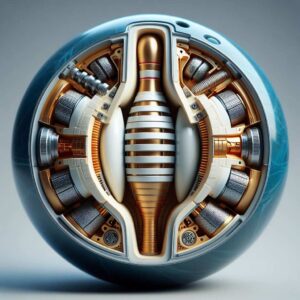As any passionate bowler knows, our bowling balls become extensions of ourselves on the lanes. We meticulously care for them, choosing the perfect weight, coverstock, and drilling layout to optimize our performance.
But what happens when our beloved ball sustains damage – be it a crack, chip, or simply a worn coverstock? Can bowling balls be repaired, or is it time to say goodbye and invest in a replacement?
In this comprehensive guide, we’ll explore the world of bowling ball repairs, covering everything from common types of damage to the steps involved in restoring your ball to pristine condition.
We’ll also discuss the costs and timelines associated with various repair services, as well as provide tips for preventing future damage to extend the life of your investment.
Can Bowling Balls Actually Be Repaired?
The short answer is yes – in many cases, damaged bowling balls can be successfully repaired. However, the extent and nature of the damage will determine whether a repair is feasible or if replacement is the better option.
Some of the most common types of bowling ball damage include:
- Cracks: Hairline cracks or larger splits in the ball’s surface can occur due to impact, improper drilling, or simple wear and tear over time. These cracks can compromise the ball’s structural integrity and performance if left unaddressed.
- Chips: Small chunks of the ball’s coverstock can break off, often due to collisions with the gutter or other hard surfaces. While unsightly, minor chips may not necessarily impact the ball’s performance.
- Worn Coverstock: Over many games, the outer layer of a bowling ball’s coverstock can become dull, dry, or cracked, reducing its responsiveness and hook potential.
Other forms of damage, such as deformities or issues with the ball’s weight block or balance holes, may be more challenging or even impossible to repair, requiring ball replacement instead.
The Bowling Ball Repair Process
If your bowling ball has sustained damage that can be repaired, the process typically involves the following steps:
- Inspection and Assessment – The first step in repairing a bowling ball is to have it thoroughly inspected by a qualified pro shop technician. They will carefully examine the ball, identify the nature and extent of the damage, and determine the appropriate course of action.
- Cleaning and Preparation – Before any repair work can begin, the ball’s surface must be meticulously cleaned and prepared. This may involve using specialized cleaners or abrasives to remove any dirt, oil, or other contaminants that could interfere with the repair process.
- Crack or Chip Filling (if possible) – For balls with cracks or chips, the technician will carefully fill the damaged areas using specialized epoxy or bonding agents. This helps to restore the ball’s structural integrity and prevent further cracking or chipping.
- Resurfacing or Refinishing – Once the damaged areas have been addressed, the technician will resurface or refinish the ball’s coverstock. This may involve sanding, buffing, or applying a new coating to restore the desired surface texture and responsiveness.
- Balancing and Testing – After the repair work is complete, the technician will carefully balance the ball and test it to ensure it meets the required specifications for weight, balance, and performance. This step is crucial to ensure the ball’s integrity and playability.
Throughout the repair process, the technician may need to consult with the ball’s manufacturer or industry experts to determine the best approach and ensure the repair is done correctly.
Cost and Turnaround Time for Bowling Ball Repairs
The cost and turnaround time for bowling ball repairs can vary significantly based on the extent of the damage and the specific services required.
For minor repairs, such as filling small cracks or chips, the cost can range from $20 to $50, with a typical turnaround time of 1-2 weeks. More extensive repairs, like resurfacing or coverstock replacement, can cost between $50 and $100, with a turnaround time of 2-4 weeks.
In some cases, if the damage is too severe or the ball is particularly valuable, the technician may recommend a full rebuilding process. This can involve completely stripping the ball’s surface, replacing the weight block or other internal components, and reassembling the ball. Rebuilding can cost upwards of $150 and may take 4-6 weeks to complete.
It’s important to note that these are just rough estimates, and actual costs and timelines may vary depending on the specific pro shop, the complexity of the repair, and any additional services required. It’s always a good idea to consult with your local pro shop for a more accurate assessment and quote.
When to Consider Replacing Instead of Repairing
While many bowling ball repairs are feasible, there are some situations where replacement may be the better option:
- Severe Cracking or Deformity: If the ball has sustained significant cracking, splitting, or other structural damage that compromises its integrity, repair may not be possible or advisable. Attempting to repair a severely damaged ball could lead to further issues down the line.
- Excessive Wear and Tear: Over time, even with proper care, a bowling ball’s coverstock can become so worn and unresponsive that it no longer performs as intended. In these cases, a full replacement may be the best solution.
- Outdated or Obsolete Models: Some older or discontinued bowling ball models may be challenging to repair due to a lack of available parts or specialized expertise. If your ball is an outdated model, it may be more cost-effective to invest in a newer, more technologically advanced replacement.
- Significant Value or Sentimental Attachment: For high-end or custom-drilled bowling balls that hold significant value or sentimental attachment, the cost of a full rebuild may be justified to preserve the ball’s integrity and performance. However, for more budget-friendly or mass-produced balls, the cost of a rebuild may outweigh the benefits.
Ultimately, the decision to repair or replace a bowling ball should be made in consultation with a trusted pro shop technician, who can provide a comprehensive assessment and recommendation based on the ball’s condition, your needs, and your budget.
Tips for Preventing Bowling Ball Damage
To help extend the life of your bowling ball and minimize the need for costly repairs, it’s important to follow proper care and maintenance practices. Here are some tips to keep your ball in top shape:
- Clean and Condition the Coverstock – Regularly Regularly cleaning your bowling ball with a specialized cleaner and conditioning the coverstock with a ball polish or rejuvenator can help prevent premature wear and tear. This helps maintain the ball’s responsiveness and hook potential.
- Store and Transport the Ball Properly – When not in use, store your bowling ball in a clean, dry environment, such as a ball bag or case. Avoid leaving it in extreme temperatures or direct sunlight, as this can cause the coverstock to dry out and become brittle. When transporting the ball, use a sturdy bag or case to protect it from bumps and impacts.
- Inspect for Damage After Every Use – Take a few moments after each bowling session to carefully inspect your ball for any signs of cracking, chipping, or other damage. Addressing issues early can prevent them from worsening over time.
- Consult with a Pro Shop Technician Regularly – Even with proper care, bowling balls can still sustain gradual wear and tear. It’s a good idea to have your ball checked by a pro shop technician every 6-12 months, or whenever you notice a significant change in its performance.
- Consider Ball Maintenance Services – Many pro shops offer specialized ball maintenance services, such as deep cleaning, resurfacing, or oil removal. These services can help keep your ball performing at its best and extend its lifespan.
- Replace the Ball When Necessary – No matter how well you care for your bowling ball, there will come a time when replacement is necessary. Pay attention to changes in the ball’s performance, response, and overall condition, and be willing to invest in a new ball when the time is right.
By following these tips, you can help prevent unnecessary damage to your bowling ball and minimize the need for costly repairs down the line.
Conclusion
Bowling balls are significant investments, both in terms of performance and personal attachment. When they sustain damage, it’s understandable to feel concerned about the repair process and whether it’s worth the effort.
The good news is that in many cases, bowling balls can be successfully repaired, restoring them to their former glory and preserving your investment.
By understanding the common types of damage, the repair process, and the associated costs and timelines, you can make an informed decision about whether to repair or replace your beloved ball.
Remember, regular maintenance and proper care are key to extending the life of your bowling ball and minimizing the need for repairs. Consult with your local pro shop technician for personalized guidance and support, and enjoy many more successful games on the lanes with your trusty, well-maintained ball.





